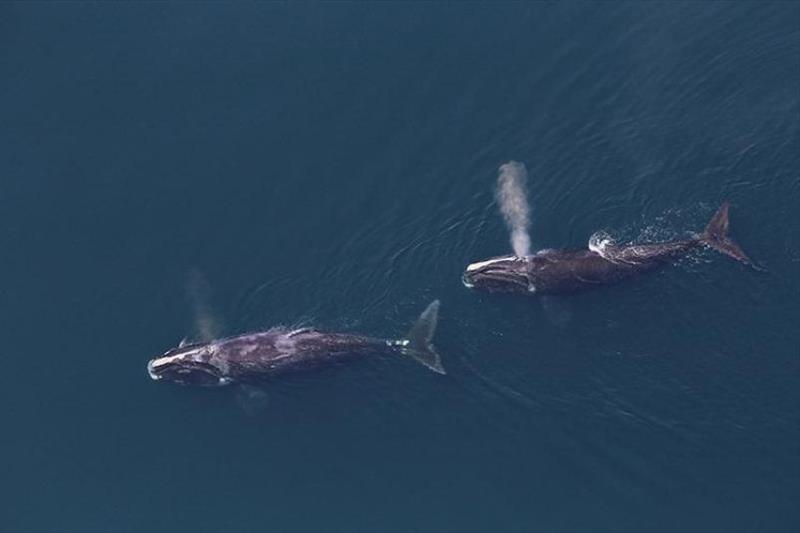
Right whale use of Southern New England wind energy areas increasing
by NOAA Fisheries 6 Aug 2021 17:43 BST

Two North Atlantic right whales, 2018 © NOAA Fisheries / Tim Cole
Right whales are increasing their use of southern New England waters, including regions slated for offshore wind energy development, according to aerial survey data collected during the last decade.
Offshore wind energy installations are proposed in waters off the south coasts of Massachusetts and Rhode Island. Understanding and minimizing the potential impacts from construction noise, increased vessel traffic, and habitat alteration will be crucial to protecting and conserving this endangered species. This research supports the Administration's goal of deploying offshore wind while protecting biodiversity and promoting ocean co-use.
The study was published July 29 in Endangered Species Research. Marine mammal researchers from NOAA Fisheries and colleagues at the New England Aquarium and the Center for Coastal Studies examined aerial survey data collected between 2011-2015 and 2017-2019. The data was collected in offshore waters including the Massachusetts and Rhode Island Wind Energy Area. The data from these two time periods were used to quantify right whale distribution, residency, demographics, and movements in the region.
"We found that right whale use of the region increased during the last decade, and since 2017 whales have been sighted there nearly every month, with large aggregations occurring during the winter and spring," said Tim Cole, lead of the whale aerial survey team at the Northeast Fisheries Science Center and a co-author of the study.
Survey data, models reveal patterns
The New England Aquarium conducted systematic aerial surveys in the region. The Northeast Fisheries Science Center and the Center for Coastal Studies conducted surveys directed to aggregations of right whales. They collected photographs of individual right whales to estimate the whales' abundance and residency. Individual right whales are identified by distinctive patches of raised tissue on their head, lips, and chin, and by scars on their body. Photographs were matched to catalogued individuals in the North Atlantic Right Whale Consortium Sighting Database. A total of 327 unique right whales were photographed in the area by the teams over the study period.
The study used the photographic data in a mark-recapture model to estimate the right whales' abundance in the area. It showed that between December and May, almost a quarter of the right whale population may be present in the region. The study also found that the residence time for individuals in the area during the winter and spring has increased to an average of 13 days over the last decade. Age and sex ratios of the whales present in the study area are similar to the species as a whole, with adult males the most common.
A whale movement model included in the study revealed that southern New England is an important destination for right whales, including pregnant females. Observations of feeding occurred in all seasons and years. Social behaviors were observed mainly during the winter and spring in all years except 2011 and 2017.
First indications of the region's importance
The first documentation of large numbers of right whales in southern New England waters occurred on April 20, 2010. The Northeast Fisheries Science Center aerial survey team identified 102 individual whales during a flight in the region. The New England Aquarium then conducted visual and acoustic monitoring during 2011-2015. They found consistent use of the region by more than one-third of the population, including 30 percent of the reproductive females. The use of the area by reproductive females is an important consideration for the species' conservation. Their overall population has declined significantly in recent years in part due to reduced calving rates.
"Since a number of large commercial offshore wind energy projects are proposed off southern New England, construction and operation of wind farms are relevant to conserving the species," Cole said. "Considerable uncertainty still exists regarding how the development of the region could have an impact on right whales just as they are becoming more reliant on the region."
Increased noise, vessel traffic, habitat alterations possible
Construction and operation of hundreds of wind turbines is likely to introduce increased ocean noise, vessel traffic and possibly habitat alteration. All of these factors have the potential to affect right whales.
Increased vessel traffic in the region will bring with it a greater risk of vessel strikes, one of the leading causes of serious injury and death of right whales.
Increased noise from wind turbine construction and operations and vessels could also directly impact important whale behaviors and interfere with the detection of critical acoustic cues. These types of impacts may also be associated with physiological stress and could affect the whales' use of the region.
The presence of wind turbine foundations may impact oceanographic and atmospheric conditions including potential changes in ocean stratification. This might alter the formation of plankton aggregations and thus foraging opportunities for right whales.
Mitigation measures will be crucial
"Implementing mitigation measures by all companies holding leases will be crucial, and should be adapted and reevaluated continually in relation to the whales' use of the area," Cole said. "Given the large-scale shifts that the species is experiencing, a variety of studies will be needed to understand potential changes in right whale distribution patterns and to inform appropriate strategies for future wind energy development."
NOAA Fisheries utilizes the best available science and works closely with the Bureau of Ocean Energy Management (the lead federal agency for offshore wind energy development) and offshore wind energy companies. We evaluate mitigation and monitoring measures and ensure compliance with the Endangered Species Act and the Marine Mammal Protection Act.
NOAA Fisheries' role in offshore wind development
Funding for the study was provided by the Bureau of Ocean Energy Management and the Massachusetts Clean Energy Center under Cooperative Agreement M17AC00002. NOAA Fisheries funded publication of the study.
For more information, please contact Shelley Dawicki at